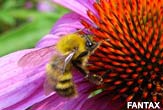Bees Employ Building Superintendents

Most bumblebees are cold-blooded. But a few are warm-blooded and need a warm nest. One type of warm-blooded bumblebee common in the Pacific Northwest has its own version of apartment-building superintendents to help with this.
In the species Bombus huntii, some colony bees are experts in controlling the nest's temperature, new research concludes.
The finding deepens entomologists' insight into the complex social lives of numerous types of bees, wasps and ants. It's commonly known that many of these insects assign roles such as queen, worker and scout to members of a colony.
In B. huntii, some workers specialize in raising the temperature of a nest to help incubate the young, while others monopolize the job of fanning their wings to cool down the next when it becomes overheated.
The weird thing is that smaller bees, rather than larger ones, tended to do the warming-up work--which looks a lot like shivering, said Sean O'Donnell of the University of Washington, co-author of a report on the finding in the journal Behavioral Ecology and Sociobiology.
"We don't know whether the smaller bees are really better at warming the nest, or whether the larger bees avoid incubating for other reasons," he said. "In general, larger bumblebees are foragers for food, and they could be committed to that task. This kind of size-based division of labor might make the colony more efficient."
No job sharing
Get the world’s most fascinating discoveries delivered straight to your inbox.
One part of the study involved challenging the bumblebee colonies by removing the most active incubating workers and cooling down the next. Instead of other worker bees coming to the aid of the warming bees, the warmers responded within 24 hours by picking up the pace of their incubation work, O'Donnell said. (Scientists who study social insects can easily track them by gluing numbered tags to the thorax of colony members.)
"They stick with certain jobs and change their rate of performance up or down to match colony needs, rather than switching among jobs," he told LiveScience.
The work of dealing with temperature fluctuations--called thermoregulation--is critical for bees. Extreme temperatures can harm developing broods, yet nests cannot be moved, O'Donnell said. But bumblebees are particularly skilled at warming up and cooling down their bodies.
"They are fuzzy, and they can generate heat with their wing muscles," he said. "They are exceptional among insects in their ability to maintain high body temperatures at cool temperatures, and this is probably a key to understanding bumble bees' success at high elevations and high latitudes- in other words, in cool climates."
Socially sophisticated
Bumblebees are well adapted to mild and even cold Arctic climates so they play an important role as pollinators of crops such as blueberries, cranberries, greenhouse-grown tomatoes, peppers and eggplants.
Bumblebees are eusocial, meaning that their colonies are divided into a single reproductive queen and many mostly sterile female workers (males play little role in the colony), O'Donnell explained. They are also more socially sophisticated than humans, some entomologists claim. O'Donnell agrees.
"Their social hierarchy is more developed than that of humans," he said. "Under most conditions, individuals cooperate and work for the social group in a more coordinated way than is typical for humans. Humans interact socially, but our selfish interests (particularly regarding reproduction) are more important than they are for eusocial insects. We humans have a modest level of sociality."
- Top 10 Unexplained Phenomena
- Image Gallery: Ants of the World
- Dancing Bees Speak in Code
- Why Bees Eat Their Kin
- All About Insects
Robin Lloyd was a senior editor at Space.com and Live Science from 2007 to 2009. She holds a B.A. degree in sociology from Smith College and a Ph.D. and M.A. degree in sociology from the University of California at Santa Barbara. She is currently a freelance science writer based in New York City and a contributing editor at Scientific American, as well as an adjunct professor at New York University's Science, Health and Environmental Reporting Program.



